My
name in lights - on the impact of American graffiti on Europe
by
Johannes Stahl *
Zur
deutschen Textfassung
Bonanza
An
unforgettable image: starting at Virginia City, a small fire spreads
rapidly over the whole map. When the flames die down, we see the Bonanza
Family riding picturesquely over the screen. The simple, convincing
image tells the story of a development that started with a powerful
band of people and ended up enthralling the whole world. If only artistic
effects could be like that ... The graffiti on the New York subways
didn't quite make it. Wherever they came, they affected the map in very
different ways: ranging from the fire-endangered steppes of youth-culture
with its susceptibility to new impulses ,
to the art scene which is quite willing to warm its hands at such a
fire but would like to have some irons in it too.
 "They
have the power, but we have the night." Würzburg-Veitshöchheim.
Foto J. Stahl, 1990. "They
have the power, but we have the night." Würzburg-Veitshöchheim.
Foto J. Stahl, 1990.
A
world culture
Graffiti's
international career on walls which were up for grabs was fast and unstoppable.
Youngsters all over the world seized on the impulses from the metropolitan
suburbs, copying the tags, technigue and ideas of their New York models
as best they could ,
but with increasing perfection. They got together, they wore their peaked
caps back-to-front; they were with it - closely observed by the commercial
strategists of youth fashion. These observations generated a mixture
of fashion, social education, creative high spirits and self-determination
generally typical of the presentation of youth culture.
Before
long there were graffiti shower curtains and even a graffiti competition
organized by - wait for it - a building society: the young competitors
were asked to devise a motto for a model house so as to foster a feeling
for their home ground and perhaps win a trip to New York .
Personal contacts were largely responsible for the impact of US sprayers
on European youth culture: Bando or the Brühl King Pin were in
touch with their New York colleagues quite early on; in Amsterdam, where
gallery-owner Yaki Kornblit had been exhibiting New York sprayers since
1983, there was soon an indigenous sprayer scene with a New York idiom
.
The scene has since proliferated: these days hardly a weekend goes by
without a spray workshop being held somewhere. Today many city councils
fund the graffiti they formerly affacked. Classics and new blood give
cities a brighter look, each action swelling the fan-clubs. Official
laurels have even been heaped on sprayer's heads: Quik's piece commands
respect in downtown Heidelberg, left intact by the municipal cleaners
who go into action every is ffiinutes to keep the romantic old centre
tidy. Rammellzee's projects adorn locations with a high public profile
Utrecht church or Frankfurt Airport. KOOR's works, finally, were no
less than a major contribution to the official start of events organized
in Brussels, Europe's 1991 cultural capital. There's no stopping the
sprayers, it seems. Even the police are more polite nowadays when asking
to see written permission for grafriti, adding almost apologetically;
we have to check all the phone-calls, but we do see that it's art ...
Go
ahead! Be an artist!
Things
are more complicated in the case of the development of graffiti in art
exhibitions. When New York sprayers embarked on their conquest of the
galleries and museums of Europe in the early eighties, a public with
traditionally well-trained eye for public walls waiting for them, a
public which at first was extremely sceptical about whether there was
a place for graffiti on the walls of art institutions. The history of
20th-century art forms the backdrop for such considerations. The source,
whether political graffiti like Heinrich Zille's, formal characteristics
like George Grosz' and Antoni Tapies' or even attitudes like Gaston
Chaissac's, aimed at storming the walls, had exercised a considerable
influence on artists. True, the walls, their signs and their impact
are only a vital humus on which artists cultivate their otherwise original
works. A similar effect was tacitly expected from the New York sprayers.
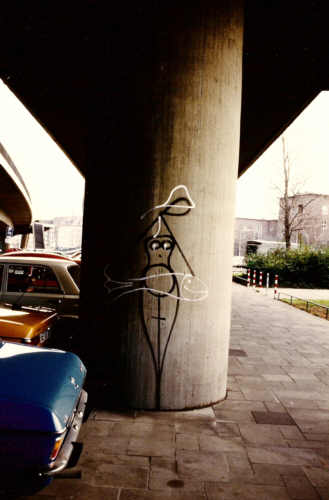 The
sprayer of Europe The
sprayer of Europe
Harald
Naegeli: Graffito in Düsseldorf. Foto J. Stahl 1985
More
important was the pest history of graffiti which already had a tradition
in Europe. The crystallization figure for such an affitude is the sprayer
of Zürich, Harald Naegeli. His US colleagues ware measured by the
expectations and notions of the ideal "sprayer" that reigned
supreme in the titles of a few book in tha early eighties.
The
turbulent student period of the' late sixties, a study of psychology
and several years of draughtsmanship behind him, Naegeli discovered
the spraycan as his means of artistic expression in the mid-seventies.
His mysterious, nocturnal, anonymous activity and the creatures he drew
on the walls of the proverbially immaculata Zürich made a phantom
hero of him. The European public willingly succumbed to his aesthetically
and morally superior inventive spirit and graphic charm. In texts which
he published himself he moreover staked the conceptual and political
claim or his work:
"We
must learn to understand Picasso's words >painting was not invented
to decorate dwellings: it is a weapon of affack and defence against
the enemy<, to understand them better than the master."
He firmly refused to sell his graffiti. Today many of those who commission
sprayed art expect it to cost no more than the material and the sprayer's
idealism, which a good dinner ought to stimulate. Harald
Naegeli's sprayed drawings referred explicitly to architecture, planning
and politics. Accustomed to this pattern, people anticipated the same
sort of thing from New York sprayers: the best place for their work
was the street; they were expected to refer to everyday reality and
it was perfectly all right for them to be political.
In
1981 this conrrontation prompted Walter Grasskamp to draw the following
characteristic comparison in Cologne: "... at the Kölnischer
Kunstverein, another sprayer called Fred (Fred Brathwaite, J.S.) operated
alongside the exhibition of photographs from the Zürich sprayer's
Totentanz series; the contrast between these two graffiti cultures was
evident - also, unfortunately, in the failure of the New York sprayer
is works to reflect his artistic standards."
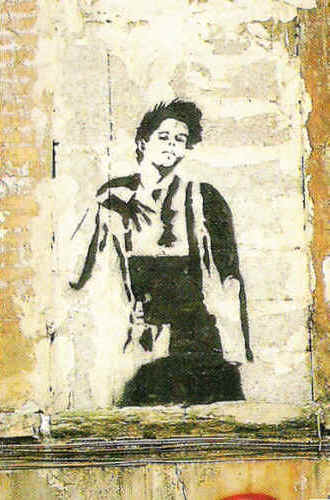 Jambon
beurre: graffiti francophones Jambon
beurre: graffiti francophones
BLEK:
Pochoir, Paris. Foto: J.Stahl, 1985
Jambon
beurre: graffiti francophones
American
graffiti encountered a special climate in France, where for years official
attempts have been made to keep colloquial French free of Americanisms.
The use of the word "weekend" for example, is deplored; a
language commission recommends "fin de semaine". Besides this,
notably in France the preoccupation with and practice of graffiti has
a strong tradition in which boasts the names of important 20th-century
artists. Universities were occupied in the late sixties, the demands
for freedom of thought and speech went hand in hand with the "Storming
of walls with words". It pleased theorists like Frank Popper and
Jean Baudrillard to place New York graffiti in the same context of ideas
.
The language barrier was not the only problem in France. Blek le Rat,
backed by his extensive study of art, could never have countenanced
the mere adoption of the New York idiom. The change of his first name
Xavier into "Zephyr" is significant: not a tribute to the
eponymous New York sprayer but the phonetic conversion into American
.
After
unsatisfactory experiments Blek turned to customary forms of political
graffiti, developing on the basis of his graphic skills an ingenious
stencil technique. This had the advantage of enabling him to work fast,
effectively but elegantly in well policed areas. Perhaps it is a consequence
of language barriers and the concomitant distribution of books that
stencilled graffiti were particularly prevalent in the francophone region,
with offshoots in Canada and Switzerland.
The
French were fairly reserved towards the New York sprayers: they held
no big exhibitions and tended to mock such exuberant treatment of walls
"Jean Bombeur", who as a matter of fact also employed the
stencil technique, became the homophous "Jambon beure" - Jean
the wall-bomber rendered into ham butter.
Unfortunately
the sprayers often encouraged such misunderstandings. Not only did they
ignore the frequently discussed political components of the public images
or dismiss them with comments such as "it's fun", but the
behavior of the writers themselves played into the hands of European
prejudice.
With
a few exceptions, spray artists presented themselves as a group and
- with rap and boogie - as a socio-cultural phenomenon of the bustling
metropolis rather than as serious artists. Compared with American or
European artists previously in the limelight, spray artists orten worked
hastily and may sometimes have really forgotten that their paintings
would be exposed to scrutiny in private collections or museums for years
to come. It was certainly asking too much of the art public to get used
overnight to these artists' totally different sense of self, which was
governed by neither spiritual, historical nor emotional standards.
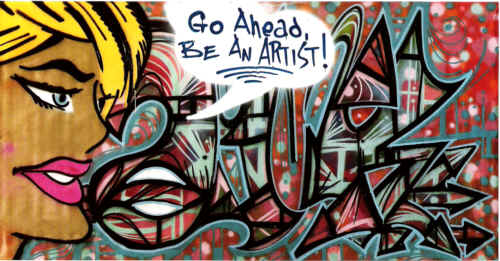 Career
models for notions of art: POP Art and Fluxus Career
models for notions of art: POP Art and Fluxus
Quik:
GO AHEAD, BE AN ARTIST! Spray on Canvas, 1990
Art
reception makes heavy going of the commonplace - the very opposite of
what is expected of art .
For American art's career from the street into the museum, this century
offers two comparable models: Pop Art and Fluxus. Today both are classical
epochs whose works have become expensive and rare; both had their first
big successes in Europe.
A
classic example was the highly successful iconoclasm of gallerist Sidney
Janis, whose POP Art stable made a powerful and lasting impact in an
amazingly short space of time: Today, names like Andy Warhol, Roy Lichtenstein
and Robert Rauschenberg are realized as having been programmatic, and
it is hard to find a European museum without their work. Indeed,many
Americans come to europe for the express purpose of viewing large groups
or works which they will seek in vain in the cradle of Pop Art (a rate
conversely suffered by, for example, Renaissance drawings). Intellectual
capital, at least, can be gained from this circumstance. No wonder that
the Dutch collector Henk Pijnenburg drew a parallel in an opening speech,
comparing the sixties and eighties: "While America looks on suspiciously,
the art robbery of the 20th century is taking place before it's very
eyes ..."
There are limits to the parallel, even if some paintings by Quik, Seen
or Crash have common roots with famous POP works, and even if Fab Five
Freddy highlighted the reference with his subway version of Warhols
"Campbell Soup Cans", it was the POP artists, declared intention
and strategy to infect art with the inherent banality of commonplace
objects. This could only happen in previously demarcated art spacesa
Commonplace objects would otherwise not have had their alienating effect
on the art framework of the museum or gallery.
The
New York sprayers, on the other hand, had longbeen established as a
high-profile secret society by the time the art rnarket pounced on their
work and induced the "writers" to spray on canvas. The true
fascination therefore did not come from the pictures and the objects
they depicted, but from the lifestyle of the sprayers. Their illegal
status, their roots in the slums, their music, were interesting. Although
their paintings were the visual expression of urban high folk art, they
were not regarded as "work" - some of them were even hung
up under gallery ceilings. It was a kind of colonialism: raw materials
were traded for social superstructure. Traditional artists frequent
collaborations with sprayers did nothing to basically change this mechanism..
.Jenny Holzer with Lady Pink; John Fekner with Crash/Daze, Keith Haring
with everybody: many of these joint projects were shortlived and confronted
the traditional artists' theoretical standards with the ambivalent,
trivial imagery of the sprayers. Whereas Pop artists had deliberately
exploited this reciprocal effect to their own advantage, graffiti artists
are still struggling to pay off their mortgages.
A
less evident comparison illustrating what Europeans expected of the
sprayers is Fluxus. A remarkable number of artists connected with this
"movement" evinced an interest in graffiti: Al Hansen, for
instance, documented New York graffiti, at the 7th documenta Kassel
in 1982 Joseph Beuys acted on behalf of the South Bronx gallery Fashion
Moda, Henry Flint recently exhibited his photographs of graffiti by
Samo '(Jean-Michel Basquiat). One expects the diverse Fluxus theories
to boil down to an art whose place is clearly outside the usual venues;
one expects artists either to expand these venues in a revolutionary
fashion or react to attempts to tame them with the heaps of ashes often
featured in museums as important Fluxus works: relics of past actions,
blurred documentary photographs, a programmatic absence of gestalt .
The
discrepancy between this expectation and the sprayers' works is manifest.
Strict rules of perfect craftsmanship applied to the subway pieces,
and even more so to the works on canvas. The conceptual considerations
envisaged by Fluxus artists, such as the creative friction of content
and form, were way out of the sprayers' league, what they wanted was
to produce convincing images like those of the advertizing world.
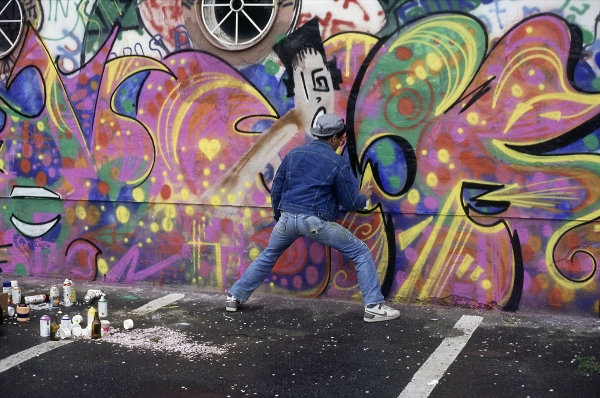 Quik
in front of his piece at the wall of the Wiesbaden-Erbenheim church,
1989. Foto: J. Stahl Quik
in front of his piece at the wall of the Wiesbaden-Erbenheim church,
1989. Foto: J. Stahl
There
is little to justify parallels between the sprayers and Fluxus except
for the movement itself. A classic example is the fate of a church in
Wiesbaden-Erbenheim, whose dignified facade was sprayed in 1982 on the
occasion of an exhibition of assembled Fluxus artists. This chaotic
treatment elicited vehement protest, albeit to no avail: the facade
was private property and the legal situation thus exactly the opposit,
of the customary procedure of spraying someone else's belongings. In
1989 the owner of the church, the Wiesbaden collector Michael Berger,
declared the facade free for fresh treatment, which was duly rendered
by local and international sprayer. Quik, whose brightly coloured tag
featured prominently on the wall, commented on the art-historical component
of the event: "It's a great feeling going over Joseph Beuys."
In
1991 the wall was taken over by Wiesbaden sprayers. Fluxus had finally
reached its goal of being permanently open to change.
 Theory Theory
The
chief obstacle to the sprayers' progress in Europe was the lack of a
theoretical superstructure. As a maffer of fact the 20th century had
never known a movement in art as devoid of theory as graffiti. As a
consequence, it was constantly regaled with external theories. To Jean
Baudrillard, graffiti exemplified the "revolution of the signs"
.
He equated the revolutionary aspect with the inability of the visitor
from Europe to grasp their meaning fully. Admittedly, he lays himself
open to the reproach of being contented with this theoretically highly
consistent result - indeed, he does not even try to understand the message.
One wonders whether it was this kindred spirit that inspired Rammellzee
to spout a bombastic jumble of theories and isms .
With the ambivalent image of himself that the multimedial artist thus
forms, he becomes - deliberately - more and more like the design in
which the european theorist would have us see the writers as unconsciously
revolutionary.
Paul
Gavarni: "Fire, my goodness, is an element of our existence."
- "Thanks a lot."
Lithograph, 1836 with an conversation between art bohemien and street
working boy.
Black
men creating Art History
Art
historiography finds it hard to cope with sprayers. In the first place
there are so many of them that even the market has trouble making a
selection .
In the second place they are not confined to the museum and gallery
context, but operate simultaneosly in many places and on many levels.
And thirdly, their development is much more uneven than that of artists
with an academic career, which is why their future as artists often
looks uncertain. Selections must therefore constantly revise their own
criteria of what good art of the "New Yoork Graffiti" brand
should look like. Significantly, A.A. Arnason makes only passing mention
of the stars among, the 10000 "graffitists" going on to single
out the very artists who have approached subway pieces via art school
.
True,
not all sprayers feel happy with art historical derivarions: "Words
like "Graffiti" and "Graffito" only minimalize,
direct and controll an art of tremendous magnitude, endless direction
and unpredictable aspects. A toad is not a frog nor a larve a fly yet
such is not the case of this inner city phenomenon ... Titles have admittedly
been used to satisfy an unreceptive "public" unprepared to
deal with the internal reality of this art and its existance."
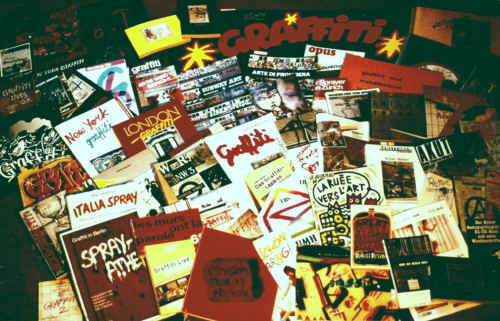 Future Future
The
only thing for a public accustomed to its own criteria to do is to closely
examine sprayers, their history and their world of ideas .
Like all backgrounds in art, their's, too, need explaining. Without
a lot of time and a bit of information about the backgrounds, little
can be obtained from the host or details in the pictures. Works like
NOC's "Style wars" show that "graffiti" pieces do
not need European art history because they have their own fascinating
story. This story is well worth listening to: it is full of' personal
experiences, the constant compulsion to make the grade in American society.
Over and over again, it is the USA's latent or overt racism that thwarts
the sprayers. So does a form of art politics that is becoming increasingly
hostile to fringe groups ,
persecuting certain forms of artistic expression with inquisitional
vigour. However: "Americans will have to come to terms with the
black man's assertion of his rights as a real person and artist..."
After all, sprayers possess a potential on which they have always drawn
and which is by no means yet depleted: their history, their observation
and their imagination. Blade, for instance, speaks of thousands of pictures
which are in his head and waiting to be painted, all prompted by subway
pieces.
That
is why the former subway artists do not deem it necessary to seek on
canvas the fresh artistic start that is so offen called for. It would
be more meaningful for criticism of such works to make a fresh start,
the only prospect of expanding its own horizon .
The paintings, whether sprayed on trains, walls or canvases, would then
acquire a life which would relativate the issue of theory, thereby enriching
an overly strict system of values.
It
may take a long time: decades elapsed between the first signs of enthusiasm
in Europe for jazz or blues and their acknowledgement as an equally
ranking culture. It depends on the beholder whether the path of spray
painting leads back into the tunnel - museum storerooms, too, are often
subterranean- or whether the sprayers' names will one day shine out
in the art-sky, as Chuck Berry dreamed of for his Johnny B. Goode: My
name in lights .....
*
This Text was - slightly altered - published in:
Coming
from the subways. New York Graffiti. Exh. Cat. Groningen (Groninger
Museum),1992 p. 26-31.
|